
Canine Lymphoma Research
Lymphoma is one of the most common cancers diagnosed in dogs. As in humans, there are multiple types of lymphoma that can be diagnosed in a canine. Collectively, they represent approximately 7-14% of all cancers diagnosed in dogs.
There are over 30 described types of canine lymphoma, and these cancers vary tremendously in their behavior. Some progress rapidly and are acutely life-threatening without treatment, while others progress very slowly and are managed as chronic, indolent diseases.
Lymphomas may affect any organ in the body, but most commonly originate in lymph nodes, before spreading to other organs such as the spleen, liver, and bone marrow.
Canine lymphomas are similar in many ways to the non-Hodgkin's lymphomas (NHL) which occur in humans. Canine lymphomas and NHL are nearly indistinguishable when examined microscopically, and both tumor types exhibit similar responses to chemotherapy.
In 2010, NHL was diagnosed in approximately 65,000 people in the United States, and claimed approximately 20,000 lives, making it the seventh most common cancer overall, and the sixth most common cause of cancer-related death. And it is one of the few human cancers for which the frequency of newly diagnosed cases is still on the rise.
It is our hope that research in canine lymphomas conducted by the Werling Comparative Oncology Research Center will discover new ways of treating NHL in both dogs and humans.
Our goal is to improve the outlook for dogs and humans affected with this all too common cancer.
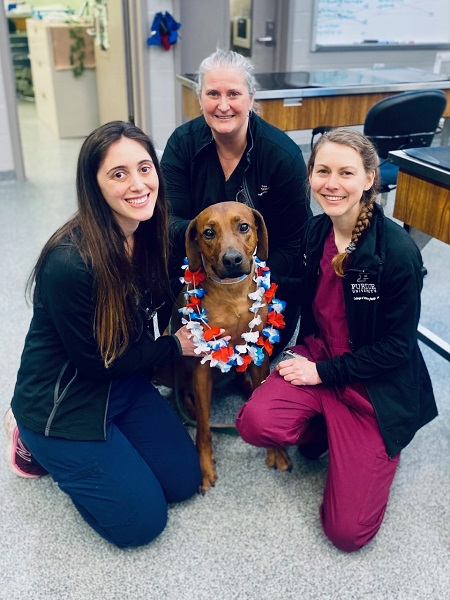
The Purdue University Small Animal Hospital was the perfect place for Harley to deal with his illness, and the doctors, students, and staff were of the highest caliber and the most gracious sentiment. We don't get to choose who occupies the spaces in our hearts, they (our dogs) just take residence, selfishly and without permission. I am so glad that they do.
Frequently Asked Questions by Pet Owners
What is lymphoma?
The term “lymphoma” describes a diverse group of cancers in dogs that are derived from white blood cells called lymphocytes. Lymphocytes normally function as part of the immune system to protect the body from infection.
Although lymphoma can affect virtually any organ in the body, it most commonly arises in organs that function as part of the immune system such as the lymph nodes, liver, spleen, and bone marrow.
By far the most common type of lymphoma in the dog is multicentric lymphoma , in which the cancer first becomes apparent in lymph nodes. Multicentric, or nodal lymphoma, compromises 80% of canine lymphoma cases.
Other common lymphomas in dogs include cutaneous lymphoma (lymphoma of the skin), alimentary or gastrointestinal lymphoma (lymphoma of the stomach and/or intestines), and mediastinal lymphoma (lymphoma involving organs within the chest, such as lymph nodes or the thymus gland).
What causes lymphoma in dogs?
Unfortunately, the cause of lymphoma in dogs is not known. Although several possible causes such as viruses, bacteria, chemical exposure, and physical factors such as strong magnetic fields have been investigated, the cause of this cancer remains obscure.
Suppression of the immune system is a known risk factor for the development of lymphoma in humans. Evidence for this includes increased rates of lymphoma in humans infected with the HIV virus or are on immune-suppressing drugs following organ transplantation surgery. However, the link between immune suppression and lymphoma in dogs is not clearly established.
What are the most common symptoms of canine lymphoma?
The most common initial symptom of multicentric lymphoma in dogs is firm, enlarged, non-painful lymph nodes.
A lymph node affected by lymphoma will feel like a hard, rubbery lump under your dog’s skin. The most easily located lymph nodes on a dog'’'s body are the submandibular lymph nodes (under the jaw, see Figure 1) and the popliteal lymph nodes (behind the knee, see Figure 2). Figure 3 shows an enlarged prescapular lymph node in a dog with lymphoma.
Other common symptoms include loss of appetite, lethargy, weight loss, swelling of the face or legs (edema), and occasionally increased thirst and urination.
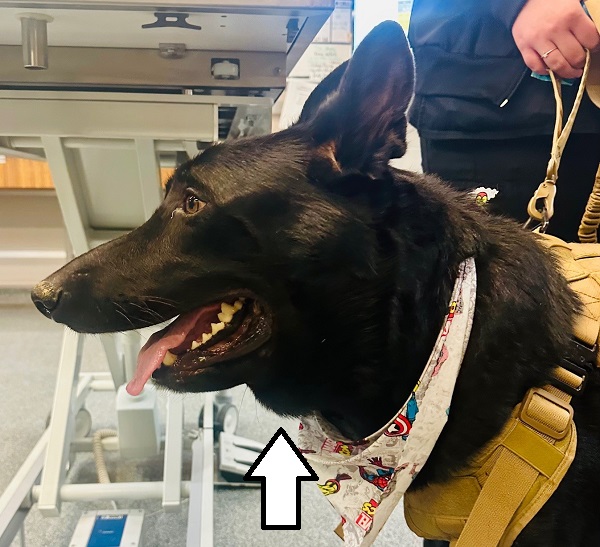
Figure 1

Figure 2
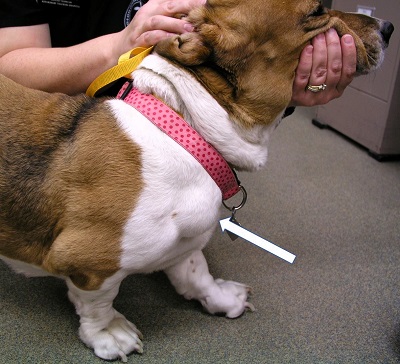
Figure 3
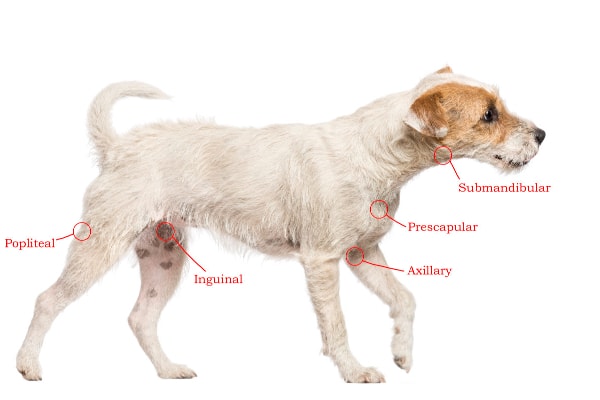
Photo By: Dr. Buzby's Toe Grips
Cutaneous Lymphoma
Cutaneous lymphoma tends to appear first as dry, flaky, red, and itchy patches of skin anywhere on the body. As the disease progresses, the skin becomes moist, ulcerated, very red, and thickened. Masses in the skin can also occur with cutaneous lymphoma.
Cutaneous lymphoma may progress slowly and often has been treated for several months as an infection or allergy before a diagnosis of lymphoma is made. Cutaneous lymphoma may also appear in the mouth, often affecting the gums, lips, and the roof of the mouth. Cutaneous lymphoma in the mouth is often mistaken for periodontal disease or gingivitis in its early stages.
Gastrointestinal Lymphoma
Dogs with gastrointestinal lymphoma usually have symptoms such as vomiting, watery diarrhea, and weight loss. The diarrhea is often very dark in color and foulsmelling.
Mediastinal Lymphoma
Dogs with mediastinal lymphoma typically have difficulty breathing, which can be seen as excessively panting or abdominal breathing, where their abdomen rises and falls as they breathe.
This may be due to the presence of a large mass within the chest or due to the accumulation of fluid within the chest (pleural effusion). Affected dogs may also show swelling of the face or front legs as well as increased thirst and urination.
How is canine lymphoma diagnosed?
The best way to diagnose lymphoma is to perform a biopsy. A biopsy is a minor surgical procedure to remove a piece of lymph node or other organ affected by cancer.
The most common methods for lymph node biopsy are Tru-cut needle biopsy, incisional wedge biopsy, or removal of an entire lymph node (excisional biopsy). The larger the biopsy sample, the better the chance for an accurate diagnosis of lymphoma.
We routinely perform biopsy procedures to diagnose canine lymphoma. Dogs are placed under heavy sedation or general anesthesia to perform the biopsy. Although discomfort associated with this procedure is typically minimal, we often prescribe oral pain medication afterwards just to be sure your dog is comfortable following the biopsy.

Are any other diagnostic tests required for dogs with lymphoma?
In addition to biopsy, we recommend several staging tests for dogs with lymphoma. The purpose of the staging tests is to determine how far the lymphoma has spread throughout your dog’s body.
In general, the more places the lymphoma has spread to, the poorer the dog’s prognosis. However, dogs with very advanced lymphoma can still be treated and experience cancer remission (see more on treatment below).
Staging tests also help us assess whether your dog has any other conditions that may affect treatment decisions or overall prognosis.
The staging tests we typically recommend include blood tests, a urinalysis, x-rays of the chest and abdomen, an abdominal sonogram, and a bone marrow aspirate. Organs that appear abnormal on sonogram can be sampled with a small needle (fine needle aspirate) to confirm the presence of lymphoma.
How is canine lymphoma treated?
The most effective therapy for most types of canine lymphoma is chemotherapy. In some cases, surgery or radiation therapy may also be recommended depending on the type of lymphoma.
There are both intravenous and oral chemotherapy treatment options for dogs with multicentric lymphoma. Most dogs with lymphoma experience remission of their cancer following treatment. Side effects of these chemotherapies are most commonly bone marrow supression and gastrointestinal effects, such as vomiting and diarrhea.
Currently, the protocol that achieves the highest rates of remission and longest overall survival times involve a combination of chemotherapy drugs given over a six month period. The protocol we consider a “gold standard” for the treatment of canine multicentric lymphoma is a 25-week protocol called CHOP, which is an acronym for all the chemotherapy drugs involved. It is based on a protocol that is commonly used to treat lymphoma in humans.
The CHOP protocol may not be appropriate for all dogs with lymphoma. Different types of lymphoma may be treated with different chemotherapy drugs. For instance, the most effective drug for cutaneous lymphoma is thought to be lomustine (CCNU), which is a type of oral chemotherapy. The veterinary oncologists and oncology residents at the hospital will help you decide on a chemotherapy treatment protocol that is appropriate for your dog.
What does remission mean?
"Remission" means a regression of your dog’s cancer. For lymphoma, the doctors can assess remission status at every chemotherapy visit.
Remission may be partial, meaning the overall cancer burden has been reduced by at least 50%, or it may be complete, meaning the cancer has become undetectable to any readily available screening test. Progression means that despite chemotherapy, the cancer has returned and the doctors will then discuss with you if there are other chemotherapy options to try.
In general, 70-90% of dogs with multicentric lymphoma treated with CHOP experience complete or partial remission of their lymphoma, with most dogs experiencing complete remission.
How is chemotherapy given at Purdue?
Most chemotherapy drugs are given by intravenous (IV) injection, although some are given by mouth as a tablet or capsule.
All intravenous chemotherapy drugs will need an IV catheter placed in one of the pet's veins in order for us to administer chemotherapy safely. A small patch of hair will be shaved from your pet’s leg where the catheter is placed for aseptic purposes.
Oral chemotherapy is given with care to ensure that the tablet or capsule does not break and spill any chemotherapy residue on the patient or personnel giving it. Oral chemotherapy should never be dissolved into a liquid or split open to sprinkle onto food. It should be given whole with the use of medical grade gloves to avoid chemotherapy exposure.
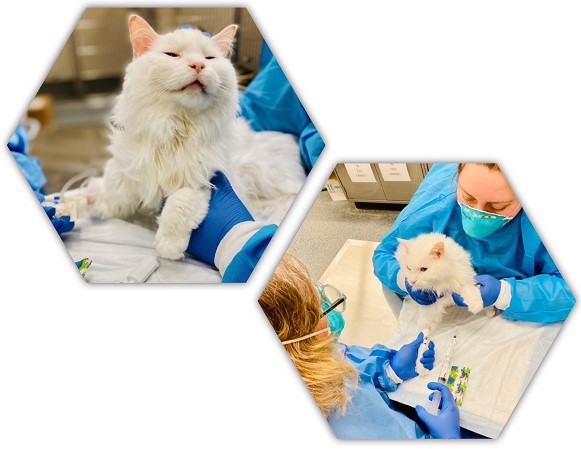
Will chemotherapy make my dog sick?
Most dogs tolerate chemotherapy well and much better than humans typically do. Chemotherapy doses in pets are much lower than doses used for humans with cancer. Although some dogs do get sick from chemotherapy, serious side effects are uncommon.
We take our goals during your pet's cancer journey very seriously. Our hope is to increase the longevity of their life, giving you more time with your loved one, while also giving your pet the ability to continue living thier life as normally as possible.
In general, fewer than 5% of dogs treated for lymphoma using chemotherapy will experience side effects that need to be managed in a hospital setting.
The most common side effects include loss of appetite, decreased activity level, and mild vomiting or diarrhea that persists for one or two days.
If serious or unacceptable side effects do occur, it is important that you talk to one of our oncology doctors or staff about this. We can reduce the chemotherapy dose to lessen side effects of chemotherapy while still ensuring we are reaching therapeutic levels to kill their cancer.
Unlike people, most dogs do not lose their hair when treated with chemotherapy. Some areas may look sparse or you might notice a slight increase in shedding. We tend to see breeds with consistently growing hair acquire what we call "chemo coat." Breeds that are known to get chemo coat are Poodles or Poodle mixed breed dogs, Shih Tzus, Havanese, Old English Sheepdogs, and Golden Retrievers.
Also, a specific intravenous chemotherapy, called doxorubicin, is notorious for causing hair loss in dogs. Hair growth will resume once chemotherapy is discontinued.
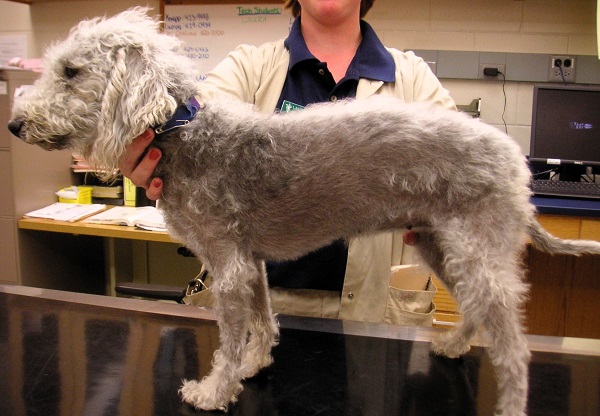
Will chemotherapy cure my dog’s lymphoma?
In rare instances, dogs are cured of their lymphoma by chemotherapy.
Unfortunately, most dogs with lymphoma will have relapse of their cancer at some point. A second remission can be achieved in a large number of dogs, but it is usually of shorter duration than the first remission. This is because the lymphoma cells become more resistant to the effects of chemotherapy as time goes on.
Eventually, most lymphomas develop resistance to all chemotherapy drugs, and dogs with lymphoma die or are euthanized when the cancer can no longer be controlled with chemotherapy.
What is the prognosis for dogs with lymphoma?
Your dog’s prognosis is determined by what type of lymphoma he or she has, if it has affected other parts of the body, and what treatment plan you decide to go with.
The median length of survival of dogs with multicentric lymphoma treated with CHOP chemotherapy is between 9-13 months. The term “median” implies that 50% of dogs will survive beyond this time point and 50% of treated dogs will die before this time point.
The oncologists and oncology residents at the hospital will discuss your dog’s prognosis in detail with you before any treatment decisions are made.
Are there any studies at Purdue involving canine lymphoma?
Yes! We are currently conducting multiple clinical trials for dogs with lymphoma at Purdue.
Varying degrees of financial support are also available to owners who agree to allow their dogs to participate in these clinical trials.
To determine whether your dog may qualify for a clinical trial, please ask your dog's primary care veterinarian to call 765-494-1130 and leave a call back message for Clinical Trials Nurse, Ms. Araynna Holland.

